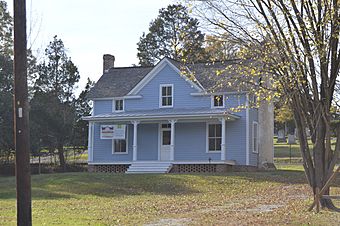Pauli Murray Family Home facts for kids
|
Pauli Murray Family Home
|
|

Front of the house
|
|
| Location | 906 Carroll St., Durham, North Carolina |
|---|---|
| Area | less than one acre |
| Built | 1898 |
| NRHP reference No. | 100000866 |
Quick facts for kids Significant dates |
|
| Added to NRHP | December 23, 2016 |
| Designated NHL | December 23, 2016 |
The Pauli Murray Center for History and Social Justice is a group that works to keep alive the important story of Pauli Murray. She was a brave and smart leader who fought for the rights of African Americans in the 1900s.
This special center is located at the Pauli Murray Family Home in Durham, North Carolina. This is the house where Pauli Murray grew up. In 2015, the house was called a "national treasure." It was also named a National Historic Landmark in 2016. This means it's a very important place in American history.
Contents
About the House
The Pauli Murray Center is in a part of Durham called West End. The house sits on a small piece of land. It is set back from the street, with a long lawn in front.
The building is a simple 1 and a half-story house. People used to call it "a story and a jump." This was because the second floor was small and had low ceilings. The house has a sloped roof and its outside walls are made of wood siding. A small roof section sticks out over the front door, which has a porch.
History of the House
Pauli Murray's grandparents, Robert and Cornelia Fitzgerald, bought the land in 1898. The house was built soon after. Pauli Murray was raised here by her grandparents and aunts from the age of three. This was after her mother passed away.
Education was very important in this home. Pauli Murray grew up to be a civil rights activist, a legal expert, a writer, and even an Episcopalian priest. She tried to get into colleges that were only for white students in the 1930s. She also tried out peaceful protests against unfair racial segregation laws. These ideas later became key parts of the successful civil rights movement.
Pauli Murray wrote important legal papers that helped shape civil rights laws. She also wrote a famous book that explained the segregation laws in every state. Ruth Bader Ginsburg, a Supreme Court Justice, said that Pauli Murray helped her with legal ideas. These ideas helped women gain more rights.
Pauli Murray wrote about her memories of the house in her 1956 book, Proud Shoes: The Story of An American Family. She said that her grandfather, Robert Fitzgerald, was blind. He supervised the building of the house by feeling his way around. She wrote that the house "was more than a home; it was a monument to Grandfather's courage and tenacity."
Bringing the House Back to Life
Work to fix up the house started in July 2015. The Pauli Murray Center received money to study the house's history. This study helped them plan how to fix it and turn it into a historic center.
Later in 2015, a company called Iron Mountain gave more money. This helped the center start fixing the house's foundation. They also began to repair the outside of the house. This fixed damage from water and neglect.
By 2016, the project was well underway. More money helped restore the outside of the house. They made it look like it did in old photos from 1898 to 1906. Missing parts like doors, the front porch, and windows were rebuilt. The house was also lifted up six inches in the middle. The old foundation was replaced with new supports. The outside color was changed from white to a blue-gray. This matched how the house looked in 1910.
In 2017, the National Park Service gave the Pauli Murray Center a large grant. This money has been used to fix up the inside of the home.
The Museum Today
The Pauli Murray Center planned for the restored house to open as a museum in 2020. It now serves as a community center for learning about history and social justice.
Because the house is small and has only a few of Pauli Murray's belongings, it is not a typical museum. Instead, it uses text panels and interactive displays to share Murray's story. It also hosts many community events.
See also



